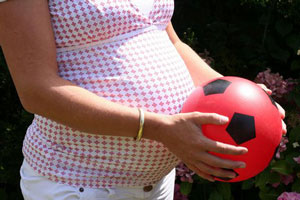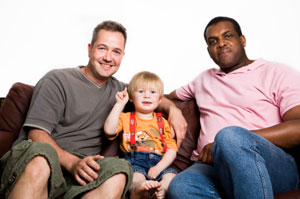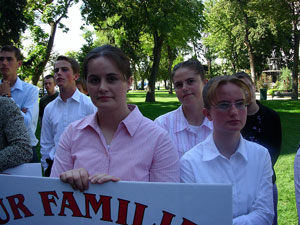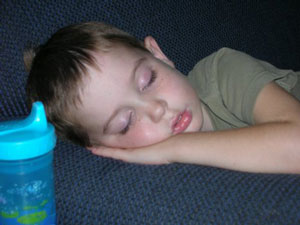Family. To many, the word conjures up images of June and Ward Cleaver with their two children, dog, and perfect house. To others, it may elicit images of the Brady Bunches’ blended family. Still others may identify with the family in the HBO series “Big Love,” a drama about a modern polygamist family. Whatever your definition of family, one thing is clear, the perception of the American family is continually changing. How are these changing views affecting family values?
Family, as defined by the Random House Dictionary is, “a basic social unit consisting of parents and their children, considered as a group, whether dwelling together or not.” The U.S. Census Bureau defines family as “A group of two people or more (one of whom is the householder) related by birth, marriage, or adoption, and residing together.” However, based on the November 2010 results of a Pew Research Center study in partnership with Time magazine, the Census Bureau’s definition is outdated.
Among the varied findings in this study, Pew found that nearly 40 percent of Americans think marriage is obsolete, and since 1960, the number of married people in America dropped by 20 percent.
Another aspect of the study showed that the personal values of those surveyed based their feelings on emerging trends. “The young show greater acceptance of the current arrangements than the older generation; the secular, liberals, and unmarried illustrate more acceptance than the religious, conservatives, and married. And in most cases, blacks show more acceptance than whites.”
The Pew study revealed some disturbing results as well; nearly one-third of the country felt the changing types of families fell into the negative category. Nearly 70 percent of Americans believe that single women should not have babies.
 Single Parent Families
Single Parent Families
The number of single parents, mostly single mothers, is on the rise. According to the Pew study, more than 40 percent of children in the U.S. were born to single mothers as of 2008, the last year in which statistics are available. When broken down by race the numbers indicated that 72 percent of black women, 53 percent of Hispanic women, and 29 percent of white women were unmarried when they gave birth.
“I was approaching 40 when I decided that I was prepared to be a single mother with donor sperm. I tried to follow the traditional trajectory — fall in love, marry, have a child — but I had spent much of my 20s and my early 30s focused primarily on my career (I’m a journalist), and then kept falling for men who wouldn’t commit,” says Pamela Ferdinand, a single mother by choice.
Ferdinand falls into the 40 percent of people who don’t find marriage necessary, according to Pew. Ferdinand and her male partner have been together for 8 years and have a 3-year-old daughter with another on the way. She says they are planning to get married “sometime in 2012, but it has not been a priority.”
“At one time, my family was the two of us. Now it’s the three of us, and soon it will be the four of us,” she adds. “The beautiful thing about what makes a family, I think, is that it can be ever-expanding and is only as limited as your own heart and mind. This seems to echo the sentiments of a lot of families who don’t fit into the conventional mold. I did not want to run out of time to be a mother, though I never ruled out having a child via adoption or other means, and I still thought I would find love one day. I also knew other single mothers who were happy with their decision, and I felt like I had the resources, relatives, friends, and male role models (if I had a son) to help me support a child on my own. It was not a choice I made lightly, or that I considered second best. I came to believe that life doesn’t necessarily have to follow a certain order.”
 Homosexual Families
Homosexual Families
Same sex relationships have gained a lot of attention in part because of public debate over same sex marriage. Same sex marriage is now legal in six states as well as within one Native American tribe in Oregon. Several states recognize same sex marriages performed in other states even though they do not perform them.
Homosexual families, like many other families, often want children of their own. The same options are available to homosexual families that are available to heterosexual families such as adoption, surrogacy, and natural birth through sperm donation.
While researching this piece, the availability of information was difficult to locate, and requests for interviews went unanswered. When building families, sexuality is something often kept secret. Some adoption agencies will allow openly gay couples to adopt as well as single gay parents.
However, some potential adoptive parents don’t disclose their sexuality for fear of being denied. There are some states, such as Michigan, that allow single gay parents to adopt, but prohibit gay couples from adopting, while Arkansas does not allow homosexuals to adopt children at all.
 Polygamist Families
Polygamist Families
This is one type of family unit where a lot of negative attention in recent years has raised it into the public spotlight because of the criminal activity exposed within one polygamist religious sect.
Polygamy translates to “many marriages,” and is mainly used in reference to a man having multiple wives, while polyandry is the term used for women who have multiple husbands. Both practices take place in the U.S., though it is far more common to see polygamy than polyandry.
Polyandry is however the way of life in some areas of the Himalayas and Tibet.
Thanks to the popularity of television shows like “Sister Wives” on TLC, polygamists are starting to distance themselves from the images associated with the Fundamentalist Church of Jesus Christ of Latter Day Saints (FLDS). While FLDS is not the only fundamentalist sect, they are the most visible, thanks in part to their recent legal problems.
“Sister Wives” demonstrates how even though unconventional, these are still families. The 13 children all seemed to be well adjusted, intelligent, and responsible, illustrating that these types of relationships are not the abusive arrangements often portrayed in the media.
Nearly all of the world’s major religions have practiced Polygamy at some point in their history, and even Muslims, Jews, and Catholics practiced polygamy in adherence to “the old ways.”
 So How Does All of This Affect Family Values?
So How Does All of This Affect Family Values?
Each family has its own unique set of values, and. There is not one universally set of beliefs that exists.
When asked about family values, Ferdinand says, “As far as single motherhood giving children different views of what family is, I firmly believe that children believe in what they know and know what they experience. Any form of healthy love in a household, whether that household is a married couple, unmarried, gay or lesbian, single mother or father, will serve them well in life. I also think my child, and many others, are lucky to live in areas where they see diverse families without the combinations of mom and dad, or mom or dad, as strange. Rather, she has an expanded view of what family can be.”
Adoption advocate, Lindsay Stepp says, “The values that families instill in their children have to do with their own upbringing, parenting styles, and choices, not with biology or adoption.
Though some children may perceive different values as they grow older and reflect on their own upbringing and adoption, I do not believe that their parents have instilled anything different in them, it is simply a process that many adopted children go through to question belief systems and their place in the family.”
 Stepp adds, “I think that most families with biological and adopted children function just as well, if not better, than other types of families because they have learned about both situations and have a greater tolerance for difference.”
Stepp adds, “I think that most families with biological and adopted children function just as well, if not better, than other types of families because they have learned about both situations and have a greater tolerance for difference.”
It’s a sad fact that sometimes adopted children face more challenges within the family, either because the adopted family treats them differently from biological children, or because adopted children often have psychological problems that adoptive parents weren’t aware of at the time of adoption. A highly publicized story about the mother who adopted a young boy from Russia and was not told of his severe psychological problems, revealed these issues. When the child began acting out violently, the mother put him on a plane back to Russia with a note pinned to his coat. It is not clear if the mother tried to get help for the boy.
“The children of unconventional families often veer one way or the other: free to question all society’s values and make individual choices, or [they] become very conventional in their own adult lives as a reaction,” says Isabella Alman, a family therapist who works with unconventional families in California. She says that the families she works with often have more liberal values than conventional families.
No matter how you define family, what really matters is the environment within that family. An abusive family is an abusive family. However, a stable loving family is a stable, loving family whether there is a single mother, mother and father, two fathers, or two mothers.
Children need to learn that it is a big world with room for everyone. We do not have to agree with everyone’s choices, but we do need to respect them. As parents, we raise our children with the values that we hold dear, but ultimately they will decide what they believe. All we can do is love them no matter what.
Sources:
http://www.nydailynews.com/news/world/2010/04/09/2010-04-09_mom_sends_ad...
http://www.gay-family-values.com/gayadoptionresources.html
http://www.childwelfare.gov/pubs/f_gay/f_gay.cfm
http://pewresearch.org/pubs/1802/decline-marriage-rise-new-families
http://www.blainerobison.com/concerns/polygamy.htm
http://tlc.discovery.com/tv/sister-wives/
http://www.npr.org/templates/story/story.php?storyId=90857818
